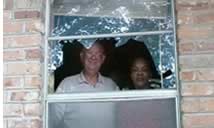Filling a Void—Origins of the Program
Mobile County District Attorney John Tyson conceived of the Good Samaritans program after he attended a presentation by famed criminologist Dr. Henry Lee and received a copy of Dr. Lee's book, Famous Crimes Revisited. In reading Dr. Lee's book, Tyson learned that crime in the United States has doubled in the past century, with two out of every five households touched by serious crime. Yet during that same period, only 19 percent of all serious crimes resulted in arrests and court cases.
That 19 percent represents diligent police work and vigorous prosecution in the face of a rising tide of crimes that often go unreported and shrinking government resources. Ultimately, though, only a small fraction of these justice system "customers" receive adequate victim service.
In Mobile, a county with a population of 400,000, for instance, the district attorney's 2 victim service officers serve the victims of more than 6,000 felony cases each year. None of Mobile County's 11 municipal law enforcement agencies or the sheriff's department has victim service officers. Only a handful of victim service professionals are available to assist the victims of thousands of violent felonies such as rape, murder, domestic violence, and child abuse.
To fill the gap in services, the Good Samaritans program trains and mobilizes volunteers to assist people after they have become victims of crime. Volunteers' focus on securing victims' homes after a break-in, offering emotional support, and linking victims with other community services.
"I realized that in our office and the justice system in general, our definition of a 'victim' was somebody for whom the case had been solved and the perpetrator arrested and put on trial," Tyson said. "That leaves thousands of crime victims in Mobile County alone who receive inadequate service from the justice system . . . or no service at all. The national number of unserved or underserved crime victims is staggering."
"Unquestionably," Tyson said, "there aren't enough police officers, prosecutors, or jailers to handle all the crime in our society or serve all its victims. In the war against crime, the justice community must call in reinforcements from the community at large: citizens."
"Good men—and women—can triumph over the evil perpetrated by criminals on law-abiding citizens," Tyson said. "With a program like the Good Samaritans, crime victims have someone to turn to."





